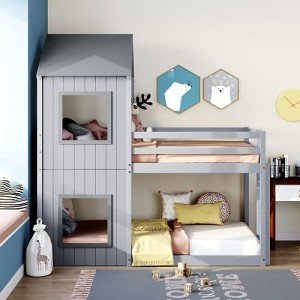The Most Negative Advice We've Ever Seen About Bunk Beds Children's Bunk Beds Children's
The Ultimate Guide to Bunk Beds for Children: Safety, Styles, and Benefits
When it comes to styling a child's space, parents typically deal with the double difficulty of making the most of space while making sure convenience and functionality. Bunk beds have become a popular solution that resolves these needs, using not just sleeping arrangements but also adding to a room's aesthetic. In this thorough guide, we will dive into different aspects of kids's bunk beds, focusing on their advantages, security functions, styles, and considerations for moms and dads considering this purchase.
Tabulation
- Benefits of Bunk Beds
- Security Features to Consider
- Kinds Of Bunk Beds
- Style and Style Options
- Upkeep Tips
- Regularly Asked Questions (FAQs)
1. Advantages of Bunk Beds
Bunk beds provide various advantages for children and their parents. Here are some essential advantages:
Space-Efficiency: Bunk beds are an exceptional option for smaller sized rooms. By stacking click through the following document on top of another, more flooring space is readily available for play, storage, or research study areas.
Affordable: When children share rooms, bunk beds can reduce the requirement for purchasing 2 separate beds, hence saving cash.
Promotes Social Interaction: Bunk beds can assist brother or sisters or friends bond by sharing a space, producing chances for social advancement.
Enjoyable Factor: The concept of sleeping “up high” adds a spirited element to bedtime, making the transition to sleeping alone simpler for some children.
Versatile Design: Bunk beds come in numerous designs, colors, and designs to match any space style, permitting for personalization that shows the child's character.
2. Security Features to Consider
Security is vital when it comes to kids's furniture, particularly when it comes to bunk beds. Here are some crucial safety features to evaluate:
Safety Feature
Description
Durable Construction
Frames made of strong wood or metal are chosen.
Guardrails
Must be at least 5 inches high and extend along both sides of the upper bunk.
Ladder Design
Guarantee ladders are firmly attached and have non-slip steps.
Bed mattress Size & & Fit
Must fit comfortably within the frame to avoid spaces.
Weight Limit
Always comply with the manufacturer's weight limitation recommendations.
3. Types of Bunk Beds
Bunk beds come in several styles, dealing with various needs, preferences, and space sizes. Here are some common types:
Standard Bunk Bed: The a lot of fundamental type, with one bed on top of another.
Loft Bed: Features a high upper bed with space underneath for a desk or play area.
Futon Bunk Bed: Combines a leading bunk with a futon on the bottom, providing flexibility for seating and sleeping.
L-Shaped Bunk Bed: This style has the top bunk set at a perpendicular angle to the bottom, developing a little corner area.
Triple Bunk Bed: Accommodates three kids using stacked beds, suitable for big families or pajama parties.
4. Style and Style Options
When it comes to picking a design for children's bunk beds, the alternatives are virtually limitless. Here are some popular designs:
Traditional Style: Often made from wood, these bunk beds feature ornate details and are ideal for timeless or rustic-themed rooms.
Modern Style: Characterized by tidy lines and minimalist designs, contemporary bunk beds can be made of metal or wood.
Themed Bunk Beds: Some brands offer bunk beds shaped like castles, automobiles, or playhouses, making bedtime less of a task.
Convertible Bunk Beds: These can be separated into two private beds, providing flexibility as children grow.
Colorful Options: Bunk beds in vibrant colors can add a sense of pleasure and playfulness to any room.
5. Maintenance Tips
Keeping a bunk bed is important for longevity and safety. Here are some ideas:
Regular Inspections: Check for loose screws or bolts every couple of months and tighten them as needed.
Cleaning up: Wipe down frames regularly to prevent dust accumulation; consider utilizing a vacuum for hard-to-reach areas.
Bed mattress Care: Rotate mattresses frequently and use protective covers to extend their life.
Watch for Wear and Tear: Look for any indications of damage in the wood or metal and consider changing parts if needed.
Teach Kids Safety Rules: Encourage kids to use ladders appropriately and ensure they comprehend the security functions of their bed.
6. Regularly Asked Questions (FAQs)
Q1: What age is suitable for sleeping in a leading bunk?
A1: Typically, kids aged 6 and older are suggested for upper bunk sleeping, as they have the necessary motor skills to climb up safely.
Q2: Do bunk beds feature a mattress?
A2: Most bunk beds are offered as frames only, so you will require to purchase mattresses individually. Guarantee that the bed mattress fits the frame comfortably.
Q3: Can bunk beds be separated later on?
A3: Many designs allow conversion into two specific beds, offering flexibility for future requirements.
Q4: How can I ensure my kid's safety on a bunk bed?
A4: Comply with security requirements and ensure guardrails, a strong frame, and a secured ladder are in location.
Q5: Are there weight limitations on bunk beds?
A5: Yes, always examine the maker's specifications concerning weight limits to guarantee security.
Bunk beds for kids can serve multiple purposes while making sure safety and design. With varied styles and models readily available on the market, parents can discover an unit that not just makes the most of bedroom space but likewise reflects their kid's unique tastes. Just like any furnishings, comprehending security features, maintenance, and how they suit a kid's lifestyle will make sure that these beds remain a practical furniture service for several years to come.
Through careful factor to consider and adherence to security standards, bunk beds can supply a long-lasting, fun, and functional sleeping option that children like.
